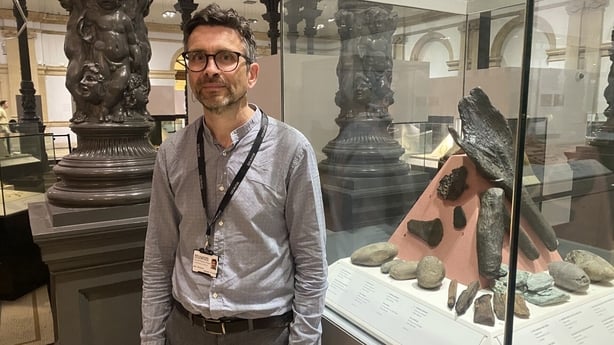The National Museum of Ireland has issued an appeal after 4,000-year-old Early Bronze Age axeheads were sent anonymously to the museum at the end of June.
The sender had fashioned packaging from a cardboard box of Flahavans Flapjacks with foam inserts inside cut to the exact size of the axeheads, each one smaller than the palm of a person's hand.
They were accompanied by a letter stating they were discovered in the Westmeath area using a metal detector.
The museum has dated the axeheads to around 2150-2000 BC.
The sender said they wished for the axeheads to be conserved by the Museum but did not provide any contact details or further specifics.
The museum said the axeheads were "thoughtfully packed in foam cut-outs and cardboard, ensuring their safe arrival."
It continued "Our experts at the NMI have identified these items as flat axeheads from the Early Bronze Age, a significant archaeological find that offers a glimpse into Ireland's distant past.
"However, to fully understand and appreciate these artefacts, it's crucial to know the exact location where they were found.
"The context of such discoveries helps archaeologists piece together ancient settlement patterns and cultural practices.
"For instance, hoards or collections of objects were often deliberately placed in specific locations for reasons that could range from ritualistic to supernatural.
"With this in mind, we are appealing to the person who sent these axeheads to reach out to us. Any information about their discovery will be treated with the utmost confidentiality and used solely to verify the find location and its circumstances."
We need your consent to load this rte-player contentWe use rte-player to manage extra content that can set cookies on your device and collect data about your activity. Please review their details and accept them to load the content.Manage Preferences
It is against the law to search for archaeological objects in Ireland using a metal detector unless you have received written consent from the Government.
People can be fined up to €63,486 and get up to three months in jail if found to be in breach of the law.
The museum said it is currently participating in an international study of Bronze Age metalwork to trace the origins of the metals used in such artefacts.
It said details about the find spot of these axeheads could provide critical data for this research.
Matthew Seaver, Assistant Keeper of Irish Antiquities at the NMI, said that the "beautiful" Chalcolithic axe heads were "among the earliest metal axes to have been used in Ireland and the metals to make them may have come from somewhere like the copper mine in Ross Island in Co Kerry".
"We are thrilled about the discovery," Mr Seaver said.
"But to truly understand their significance, we need to know where they were found," he added.

Mr Seaver said the individual that found the objects "put a note in with them saying firstly they had been found together, which is important, that they had been found in Westmeath and they had been found using a detection device, so a metal detector".
He said the person was "unwilling to give their personal details because they were aware of the law around the restrictions on using metal detectors to search for archaeological objects".
"Our appeal is really to the finder or the landowner to come forward with information about the finding spot," he said.
The assistant keeper said that any information received "would be treated in confidence and would only be used to fill out the discovery of the object".
He said: "The importance of context is everything.
"An object on its own is valuable in one sense, but an object in its context tells us something about where and why these objects were used.
For instance... in a bog, in a river or in proximity to another monument.
"Things that gave these objects meaning were where they were placed in the landscape."
He also spoke of the importance of the public reporting archaeological finds.
Mr Seaver said it "is our legal duty to report the discovery of archaeological objects".
"The NMI's role is to preserve these treasures for everyone in the State, ensuring they are available for future generations," he said.
Mr Seaver thanked members of the public "who every week find archaeological objects legitimately and report them within 96 hours as the Irish law outlines".
"We also wish to remind everyone about the regulations surrounding the use of metal detectors for searching archaeological objects," he said.
"Archaeological finds without a known owner are the property of the State and are preserved as part of our collective heritage in national and designated museums," he added.






